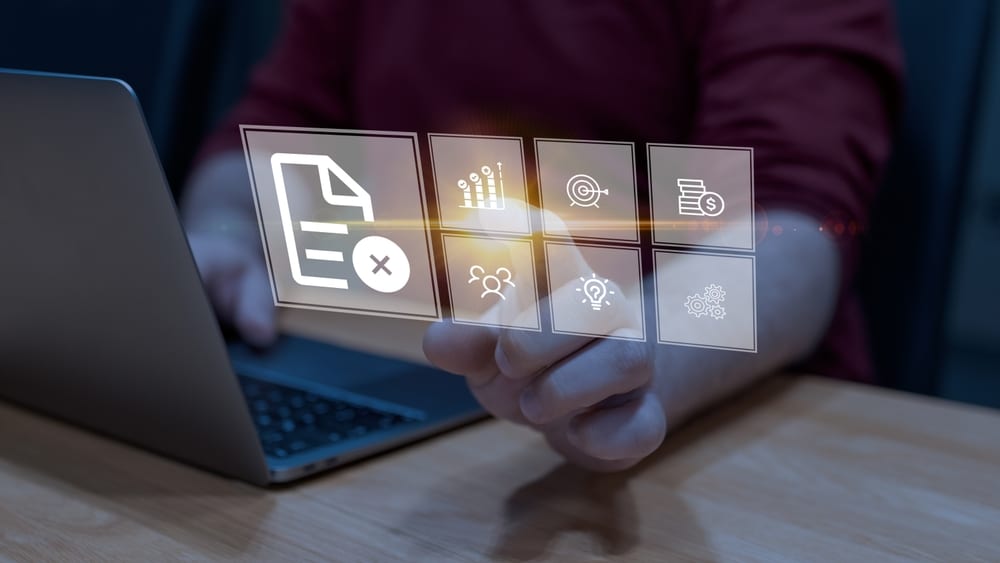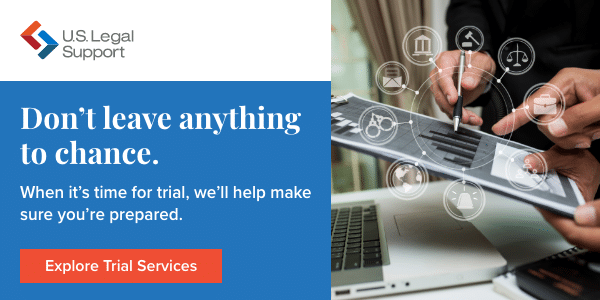Litigation Automation: Streamlining Legal Workflows

What could you do for your clients if you sliced away a quarter or more of your current day-to-day tasks? A landmark McKinsey study estimated that simply by using existing technology, attorneys could automate roughly 23% (and paralegals 69%) of their work—and that was before the generative AI explosion.1
The efficiency automation brings also impacts a firm’s bottom line. A 2024 survey of 2,200 attorneys and corporate executives showed respondents anticipate an additional $100,000 of annual billable time for lawyers who automate document review, legal research, and contract analysis with AI-powered tools.2
Streamlining your workflows through litigation automation doesn’t just free up attorney time better spent on strategic work—it can improve results and help you better serve your clients.
Defining Litigation Automation
Attorneys and firms manage countless documents and processes, including poring over vast amounts of data, which consumes valuable time.
Litigation automation is a blanket term encompassing technology that takes over work steps and tasks involved in the legal process, especially rote work. From handling a new client inquiry to filing final case documents, many legal workflows can be completed without direct human handling.
The broad goals of automation are to:
- Create time and cost efficiencies
- Improve accuracy and results
- Reduce manual labor
Use Cases: How Law Firms and Legal Departments Use Automation
Understanding the pros of litigation automation starts with an exploration of exactly what it can replace and enhance.
Legal Research
The benefits of automating legal research, including evidence collection, eDiscovery, and case law, are significant. It’s not a matter of replacing humans, but creating a supercharged assistant that can:
- Take on the time-consuming work of basic research
- Speed the process of discovering, reviewing, and tagging thousands of files
- Access a mix of public records, social media, internet archives, and proprietary data
And it’s not just basic “find all instances of X” research that AI-powered research tools can accomplish. With machine-learning capabilities, they can:
- Identify patterns, relationships, and connections
- Suggest new ideas for inquiry or strategy
- Summarize data and findings
- Draft potential deposition target lists, examination questions, and arguments
Document Management
Document management is front-and-center for litigation automation, as legal documents require strict yet consistent procedures on drafting, review, routing, and storage. Generally, these workflows build out the infrastructure to:
- Draft contracts and agreements based on templates and simple prompts
- Manage file naming, versioning, edit history, and storage
- Automate the execution of reviews and approvals
- Facilitate final document delivery, filing, and distribution
- Use the latest protocols to ensure security
Case Management
A legal case management system is a single platform that handles cases from intake to closure. They can automate multiple steps of case progression, including:
- Providing a single source for client and case information
- Project management, including task assignment and timeline and deadline tracking
- Scheduling appointments, sending reminders, and routine correspondence
- Client-facing portals that facilitate delivery and receipt of communications and forms
- Time tracking that connects seamlessly to invoicing, expense tracking, and accounting
Client Intake
Assessing a potential client before deciding whether to take their case can be time-consuming, particularly for attorneys who provide services for laypersons with little to no legal familiarity.
Rather than an extended back-and-forth to collect the right data and documents before a lengthy sit-down, the right automated software can:
- Automate responses to initial inquiries
- Prompt potential clients to fill out pre-meeting forms and provide required details
- Guide individuals in self-scheduling an initial consultation
- Assist with information review
- Complete a conflict of interest check
- Perform early case assessment and identification of key issues
- Employ litigation analytics to predict the chance of a successful outcome
Faster Court Reporting and Deposition Scheduling
Rather than going back and forth with calls and emails to find a time that works for everyone, an automated system can adapt in real time as open blocks fill up on individual schedules and meetings need to be moved around.
Key Benefits of Legal Workflow Automation
The right mix of automated workflows depends on each firm’s unique needs, but there are benefits that apply regardless of your final software stack.
Standardization
No matter the size or practice area of your firm, branding is vital to building and maintaining your professional reputation. Litigation automation won’t give you a new logo or tagline, but it provides major support in securing one of the most important components of brand management—consistency.
By standardizing document templates, language, and processes, you can ensure that every digital and textual point of contact with your clients aligns with your firm’s values and tone of voice.
Plus, having a flock of attorneys each work from their own spreadsheets and email accounts to accumulate data and draft copy takes time, provides a greater-than-necessary opportunity for human error, and leaves holes in client and case knowledge that should be centrally managed.
Time Savings
While many firms are shifting away from billable hours as a compensation framework, identifying the split of time between 1) rote or administrative work and 2) strategic work is more vital than ever to help define how litigation automation moves minutes from the first to the second category.3
While shifting to new workflows requires an initial learning curve, it’s a drop in the bucket compared to the hours that attorneys can save over the course of a year by eliminating manual and paper-based processes in favor of automation.
The Money Factor
The specific dollars and cents will differ firm to firm, but at the end of the day, litigation automation is a low-risk way to:
- Identify overstaffing at an administrative level
- Redirect misspent attorney time to strategic, client-focused work
- Streamline billing and collections
- Reduce time and expense tracking inaccuracies and billing errors
You’ll find the potential for both cost savings and increased profits when you provide a pathway for attorneys to focus on more strategic case work.
Error Reduction
Automation also promises increased accuracy in research, document management, meeting deadlines, and more. For humans, performing repetitive and inherently simpler work functions comes with a higher incidence of error based on:
- Overconfidence
- Attention span limits and boredom
- Eye fatigue, especially with electronic screens
Automating such tasks side-steps these perils while also providing a digital record of what steps have been completed.
Client Service
More accuracy and more time to spend on strategic work can lead to an upgrade in client service. Plus, leveraging automation during client intake and early case assessment helps you better identify good fits for your firm and create an efficient workflow from the starting line.
Improved Collaboration
Many litigation automation systems are inherently collaborative, and others enhance the opportunity for teamwork. This includes:
- Facilitated and realtime communications and document sharing
- Information-sharing and key knowledge identification via centralized systems
- Built-in time, task, and deadline management tools
Gains in Attorney Recruitment and Retention
Attracting and retaining high-performing lawyers is a challenge. Law school enrollments are down nearly 25% since 2010, and average associate attrition is up to 20%, but the demand for legal services continues to grow4,5.,
Litigation automation can help you secure and preserve your talent pool by:
- Showcasing your firm’s ability to stay current with technology shifts
- Allowing attorneys more time to act in their higher-function capacities
- Freeing them up from irritating administrative functions
- Providing more time for mentorship, collaboration, and professional development
- Helping your firm meet work-life balance commitments
Choosing the Right Litigation Automation Tools
Before you commit to new systems, shop around and compare your options. Consider:
- User-friendliness and implementation effort
- Ability to integrate with other tools or software you use
- Scalability
- Security
- Initial and long-term costs
- Support and training
- Quality of built-in reporting with useful metrics
Litigation automation isn’t just for large firms. Solo practitioners and small practices can build a system that fits their needs—without a deep technology budget—from off-the-shelf (and even free) solutions.6
Final Thoughts: Embracing Efficiency in the Legal Industry
Litigation automation reduces repetitive tasks, allowing attorneys to focus more on case strategy and outcomes. At the same time, it improves output accuracy and workflow efficiency.
You can also improve your firm’s accuracy and efficiency by connecting with partners that bring both technological solutions and a deep well of expertise for your litigation support needs.
That’s where the trial services division of U.S. Legal Support—the home of our elite TrialQuest team—can help you shine. We understand the challenges of bringing a case to a successful outcome and offer the best in voir dire and jury research and consulting, mock trials, witness preparation, trial graphics, demonstratives, and trial presentation and technology services.
Our experienced jury consultants, Ph.D. behavioral scientists, and psychologists have collectively consulted on more than 53,000 high-risk trials, arbitrations, and mediations, covering nearly all practice areas and jurisdictions.
U.S. Legal Support also works with a network of 5,000+ court reporters and transcriptionists nationwide and offers record retrieval and analysis, interpreting and translation services, and more, all managed via a secure Client Portal.
Interested in learning more? Contact us today to find out how we can help you streamline your workflows through litigation automation.
Sources:
- Tableau Public: McKinsey Global Institute. Automation and US Jobs [Lawyers]. https://public.tableau.com/app/profile/mckinsey.analytics/viz/AutomationandUSjobs/Technicalpotentialforautomation
- Thomson Reuters. How AI is transforming the legal profession (2025). https://legal.thomsonreuters.com/blog/how-ai-is-transforming-the-legal-profession/
- Lawyerist. A New Approach to Law Firm Compensation. https://lawyerist.com/hiring-staffing/compensation/
- The NALP Foundation for Law Career Research and Education. Update on Associate Attrition (2024). https://www.nalpfoundation.org/news/the-nalp-foundation-releases-latest-update-on-associate-attrition-and-hiring-(cy-24)
- LawHub. Enrollment and admission standards. https://www.lawhub.org/trends/enrollment
ARAG Legal. How a Small Practice Attorney Used Automation to Build Profits and Reclaim Time. https://www.araglegal.com/attorneys/learning-center/topics/practice-management-technology/how-to-automate-administrative-tasks-for-your-firm

Editoral Policy
Content published on the U.S. Legal Support blog is reviewed by professionals in the legal and litigation support services field to help ensure accurate information. The information provided in this blog is for informational purposes only and should not be construed as legal advice for attorneys or clients.


